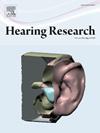结合通道失活与动态电流聚焦对人工耳蜗植入成人的言语表现
IF 2.5
2区 医学
Q1 AUDIOLOGY & SPEECH-LANGUAGE PATHOLOGY
引用次数: 0
摘要
目的与方法:人工耳蜗听者在噪声环境下的言语理解存在困难。激活重叠神经群的通道相互作用降低了解释复杂信号所需的信号精度。基于集中检测阈值优化编程策略以减少通道交互,从而提高了性能。在目前的研究中,结合了之前提出的两种方法,通道失活和聚焦动态三极刺激。利用基于聚焦检测阈值的自动通道选择算法,采用聚焦刺激、单极刺激、动态聚焦和混合方案,建立了三个具有相同失活通道但通道比例不同的人工耳蜗植入程序。采用先进仿生HiRes90k装置对11名成人人工耳蜗听者的13只耳朵进行了测试。以安静和噪音环境下的元音识别和句子感知为结局指标,评估听力经验、年龄、临床辅音-核-辅音表现和感知阈值对言语表现的影响。结果:在受试者中,不同程度的专注显示了单极程序对元音和句子的个人表现的改善。专注倾听对人工耳蜗植入经验较少的人有好处,临床表现不佳的人似乎比表现良好的人从专注中获益更多。然而,只有轻微的趋势,没有观察到明显的组改善。结论:目前的研究结果表明,对某些个体,尤其是表现不佳的个体来说,关闭和聚焦通道子集可能会改善语言表现,这可能是通道相互作用减少的结果。研究结果还表明,个人的表现在很大程度上是不同的。本文章由计算机程序翻译,如有差异,请以英文原文为准。
Speech performance in adults with cochlear implants using combined channel deactivation and dynamic current focusing
Objectives and Methods:
Cochlear implant listeners show difficulties in understanding speech in noise. Channel interactions from activating overlapping neural populations reduce the signal accuracy necessary to interpret complex signals. Optimizing programming strategies based on focused detection thresholds to reduce channel interactions has led to improved performance. In the current study, two previously suggested methods, channel deactivation and focused dynamic tripolar stimulation, were combined. Utilizing an automatic channel selection algorithm from focused detection threshold profiles, three cochlear implant programs were created with the same deactivated channels but varying proportions of channels employing focused stimulation, monopolar, dynamic focused and a mixed program. Thirteen ears in eleven adult cochlear implant listeners with Advanced Bionics HiRes90k devices were tested. Vowel identification and sentence perception in quiet and noise served as outcome measures, and the influences of listening experience, age, clinical consonant-nucleus-consonant performance, and perceptual thresholds on speech performance were assessed.
Results:
Across subjects, different degrees of focusing showed individual performance improvements for vowels and sentences over the monopolar program. Focused listening benefits were shown for individuals with less cochlear implant experience, and clinically poor performers seem to benefit more from focusing than good performers. However, only slight trends and no significant group improvements were observed.
Conclusion:
The current findings suggest that deactivating and focusing subsets of channels might improve speech performance for some individuals, especially poor performers, a possible effect of reduced channel interactions. The findings also show that performance is largely variable among individuals.
求助全文
通过发布文献求助,成功后即可免费获取论文全文。
去求助
来源期刊

Hearing Research
医学-耳鼻喉科学
CiteScore
5.30
自引率
14.30%
发文量
163
审稿时长
75 days
期刊介绍:
The aim of the journal is to provide a forum for papers concerned with basic peripheral and central auditory mechanisms. Emphasis is on experimental and clinical studies, but theoretical and methodological papers will also be considered. The journal publishes original research papers, review and mini- review articles, rapid communications, method/protocol and perspective articles.
Papers submitted should deal with auditory anatomy, physiology, psychophysics, imaging, modeling and behavioural studies in animals and humans, as well as hearing aids and cochlear implants. Papers dealing with the vestibular system are also considered for publication. Papers on comparative aspects of hearing and on effects of drugs and environmental contaminants on hearing function will also be considered. Clinical papers will be accepted when they contribute to the understanding of normal and pathological hearing functions.
 求助内容:
求助内容: 应助结果提醒方式:
应助结果提醒方式:


